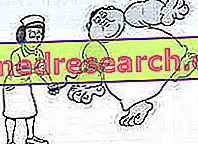What's this
What is Bagòss?
Bagòss is a mature cheese (1 to 4 years old), with a classic appearance of mountain tomes - but larger - characterized by the addition of saffron - in the curd - during production.

It is made from raw and partially skimmed cow's milk; the pasta is totally cooked. It has all the characteristics of malga cheese; the winter one or "invernengo" - produced from the milk of cows that also feed on fodder - is considered slightly less valuable.
Typical of the Lombardy region, more precisely of Bagolino - province of Brescia, in the Caffaro Valley and high Val Sabbia - the Bagòss enjoys the recognition of Traditional Agri-food Product (PAT). The name Bagòss derives from "bagossi", that is the name of the inhabitants of bagolino.
As a nutritional source of high biological value proteins, vitamin B2 (riboflavin), phosphorus and calcium, Bagòss belongs to the second fundamental food group. It is also quite caloric, quite fat, rich in cholesterol and sodium.
Bagòss is a cheese to be enjoyed especially alone; however it is also widely used grated on first courses.
Nutritional Properties
Nutritional properties of Bagòss
Bagòss is a cheese and as such it belongs to the second fundamental food group.
It has a caloric intake and a very high percentage of fats, attributes that increase with seasoning - lipids are never less than 20% on the dry substance.
Energy is therefore supplied mainly by fats, followed by proteins and finally by few carbohydrates. Fatty acids are mostly saturated, peptides with high biological value - that is they contain all the essential amino acids in the right proportions with respect to the human model - and simple carbohydrates.
Bagòss does not contain fiber and is rich in cholesterol. As seasoning increases it loses lactose and is enriched with histamine. The quantity of purines is very limited. Gluten is absent.
The vitamin profile is characterized by the abundance of riboflavin (vit B2) and equivalent retinol (vitamin A and RAE). There is no lack of other water-soluble factors of group B such as thiamine (vit B1) and niacin (vit PP). As for minerals, Bagòss shows significant concentrations of calcium, phosphorus and sodium.
Diet
Bagòss diet and cheese
Bagòss is a hyper-calorie and hyperlipidic food that does not lend itself to the low-calorie normolipid weight loss diet against overweight - especially serious ones. The seasoned one, if grated in the first courses, is given in portions of 5-10 g at a time.
The prevalence of saturated fatty acids and the abundance of cholesterol make Bagòss not recommended in case of hypercholesterolemia.
Thanks to the high biological value of proteins, Bagòss can be considered an excellent source of essential amino acids. It is indicated in all circumstances that require increasing these nutrients - for example general or specific malnutrition, malabsorption, increased nutritional demand such as during pregnancy or by practicing excessively intense and prolonged sports, etc. This function is however limited by the "less valuable" nutritional characteristics of the cheese, which require the use of moderate consumption and frequency portions.
Lactose, present only in traces due to the abundant maturing, makes it inadequate for the diet due to the specific intolerance of the most sensitive subjects. On the other hand, increasing maturation also increases the level of histamine, making it unsuitable for the diet against this type of food intolerance. It is relevant to the diet against celiac disease and hyperuricemia.
Given the wide range of water-soluble vitamins of group B, which mainly perform the task of coenzymes, cheese can be considered a very nutritious food and useful to support various processes of cellular metabolism. In Bagòss there is also an abundance of liposoluble vitamin A - or retinol equivalents (RAE) - which is necessary to maintain visual function, reproductive capacity, cellular differentiation, etc.
Given the high concentration of sodium, Bagòss cheese must be avoided or significantly limited in the diet against sodium sensitive hypertension.
The abundance of calcium and phosphorus is a very useful nutritional property to optimize skeletal metabolism, for example during growth, during pregnancy (in which Bagòss, for hygienic reasons, must be cooked) and in the third age - prevention of bone loss from osteoporosis. Note : Vitamin D is also required for bone health.
It is not allowed in vegan. Due to the presence of animal rennet, it must also be excluded in the vegetarian one. It has no contraindications for the Muslim and Jewish religions. The opinions of observant Buddhists are conflicting in this regard.
The average portion of Bagòss cheese is about 80 g.
Description
Description of Bagòss
The Bagòss is large in size - at least 40-55 cm in diameter - with a flattened circular shape - the heel, straight, is about 10.5-12 cm. The weight is between 14-22 kg - depending on whether winter or summer.
The Bagòss crust, which is not too thick but increases with aging, is dark brown or reddish - when maturing, it is regularly greased with pasteurized linseed oil which tends to oxidize.
Bagòss has a compact, uniform paste with a very fine eye. The consistency is very hard, not very elastic and shatters into flakes; the color is straw yellow. It seems very similar to the Nostrano "Valtrompia" cheese from Brescia, which, on the other hand, enjoys the recognition of Protected Designation of Origin (DOP).
The flavor of Bagòss is full, rich, aromatic, spicy with increasing aging and never bitter; the addition of saffron is not perceptible. The prevailing taste is the savory one.
The Bagòss is not all the same. Since the annual production is without interruptions, the Bagòss takes on distinctive characteristics depending on the type of milk: from the mountain pasture - summer period - or valley floor - winter period. To change the property of the milk, and therefore of the finished cheese, in addition to the processing and maturing climate, is the chemical composition of the liquid, influenced by the feeding of the livestock - fresh grass or hay with feed.
Kitchen
Bagòss in the kitchen
Locally, or more generally north of the peninsula, the Bagòss often appears among the starters or among the dishes based on dairy products; it is frequent to combine salami or other typical foods (rye bread, fried polenta in lard etc.). It is eaten alone especially in the first year of seasoning; very seasoned instead, it is more often used grated.
Grated Bagòss lends itself to accompanying various kinds of dry and soupy first courses, especially cereals, legumes and vegetables - or derivatives. Polenta with Bagòss, spooned or roasted, is very well known, both with melted cheese and fondue - with milk cream. Famous the "mereconde", or a soup with cheese and breadcrumbs, egg, parsley and broth. Noteworthy are the filled pasta from Bagòss, such as ravioli. Long pastas (eg pappardelle) and short (eg es penne), egg-based or semolina pasta, also in broth (maltagliati), lend themselves to being enriched with this cheese. Note the cereal and legume soups with grated Bagòss. Some grate Bagòss even on canederli.
It can also be used to season second courses of various kinds such as, for example, grilled fillet - with Bagòss fondue.
Generally, the recipes with Bagòss in which the flavor of the cheese is prevalent, or that of only 12 months, are associated with red wines such as the Franciacorta Rosso, the Capriano del Colle, the Garnet or the Marquis of Villamarina.
Production
Production of Bagòss
Bagòss is a cow's milk cheese - Bruna or Pezzata Rossa breed.
It can be from the malga or invernengo. The first is produced directly in the high mountains, where the cattle graze freely; the second in the valley floor plants, with milk supplied by the Malaghes, which partially feed the animals with various forages (straw, etc.). The cheese making technique is the same.
The raw milk of several milkings is heated in copper pots over low heat up to 37-39 ° C. Then the powder rennet is added (1.5 - 2.5 g on 100 kg of milk), it is mixed and left to rest for 45-70 minutes; coagulation and development of thermophilic lactic bacteria occurs.
The curd is broken: first the mass is cut with the so-called "sword" or with the "lira", turning the cheese mass through the "spannarola", waiting for the deposit on the bottom; then it ends up crushing it with the "spino" making it fine and thin.
The whole is cooked at 47-57 ° C. Saffron is then added to the curd to increase the pigmentation in yellow. The mass is filtered with cloths to drain the whey, placed in "fascere" (molds) and pressed for 24 hours.
We proceed to dry salting with coarse salt, alternately on the faces and on the barefoot.
It ends with the aging of at least 12 and up to 48 months, during which the rind is repeatedly scraped and greased with linseed oil - once raw, pasteurized today. From 100 kg of milk 5-6 kg of cheese are obtained; the yield is 8-9% at 24 hours and 5-7% at full maturity.



